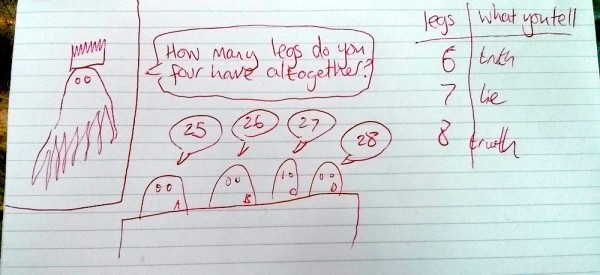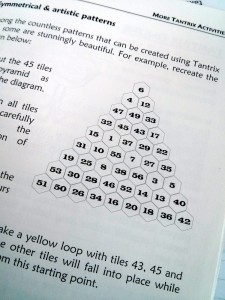We started the evening with a logic puzzle Paul had found on Stack Exchange, which is detailed in the diagram we drew:

For those not able to read the language of diagram fluently, the puzzle goes as follows. The king of the octopuses has four servants, and the servants have either 6,7 or 8 legs. Servants with 7 legs always lie, and servants with 6 or 8 legs always tell the truth. The king asks ‘How many legs do you four have in total?’, and the four octopus servants (who are standing behind a table, so you can’t see their legs) answer 25, 26, 27 and 28 respectively. Who is telling the truth?
Inspired by this puzzle, and how well it went down, we moved onto other similar logic puzzles. A recent blog post by Tanya Khovanova discusses a selection of such problems, and in fact our MathsJam attendees complained about each puzzle in precisely the way that each next puzzle was an improvement on the previous, which sort of freaked me out a bit. We had fun with the last one, but we think we have it figured!

We had a few new attendees this month, who got stuck in to some of the puzzles, and once more the magnificent Sam brought cake (which had fruit on it, so it was healthy). We played around with Tantrix tiles, including this quite nice puzzle (right) where you lay out the numbered tiles and then flip them over in place, resulting in a layout which can be made to all connect correctly when the tiles are rotated in place.
We also played with a couple of puzzles recently posted on Futility Closet:
An efficiency-minded pharmacist has just received a shipment of 10 bottles of pills when the manufacturer calls to say that there’s been an error — nine of the bottles contain pills that weigh 5 grams apiece, which is correct, but the pills in the remaining bottle weigh 6 grams apiece. The pharmacist could find the bad batch by simply weighing one pill from each bottle, but he hits on a way to accomplish this with a single weighing. What does he do?
The follow-up puzzle:
Suppose there are six bottles of pills, and more than one of them may contain defective pills that weigh 6 grams instead of 5. How can we identify the bad bottles with a single weighing?
There were a few nice puzzles floating around on Twitter, which we didn’t quite get round to.
EDB: Take a 2^nx2^n grid & delete 1 square. Can the rest be tiled by L shapes of 3 squares?
— Maths Jam (@MathsJam) February 18, 2014
A good puzzle from a very squashed London @mathsjam #mathsJam pic.twitter.com/gVO992Besn
— Matthew Scroggs (@mscroggs) February 18, 2014
We also got wound up by this voucher, which prompted a short exchange on Twitter with Thornton’s, and a discussion about previous examples of poor units discipline from companies (including the classic Verizon $0.02/0.02¢ debacle):
MAN: We are mostly being annoyed at this ambiguous and dimensionally impossible offer from @thorntonschocs. pic.twitter.com/k6RBVuv0SF
— Maths Jam (@MathsJam) February 18, 2014
We also gave the NorthWest Python members in attendance some programming to do, in order to calculate some facts about the digits of Pi, which resulted in some nice discussion of ways to program things to solve puzzles – Robie brought along his copy of One Tough Puzzle, and showed us the code his brother had written to calculate the solution.
We had a fairly early finish (around 10pm), and we all left happy in the knowledge that at least we weren’t drunk by 7pm, unlike Cardiff:
CDF: WOO BABY CARDIFF IS HERE BRING ON TEH SEXY MATHS WOO BABY YEAH #youknowit
— Maths Jam (@MathsJam) February 18, 2014
We’ve got a bunch of Tanya’s octopus puzzles in Playing With Math: Stories from Math Circles, Homeschoolers, and Passionate Teachers, which is coming out soon!